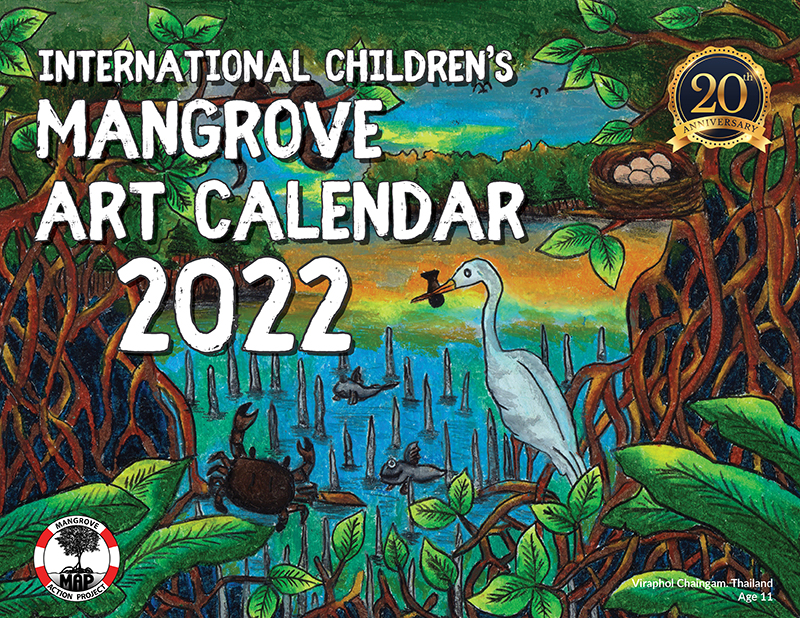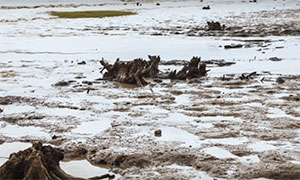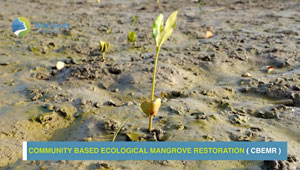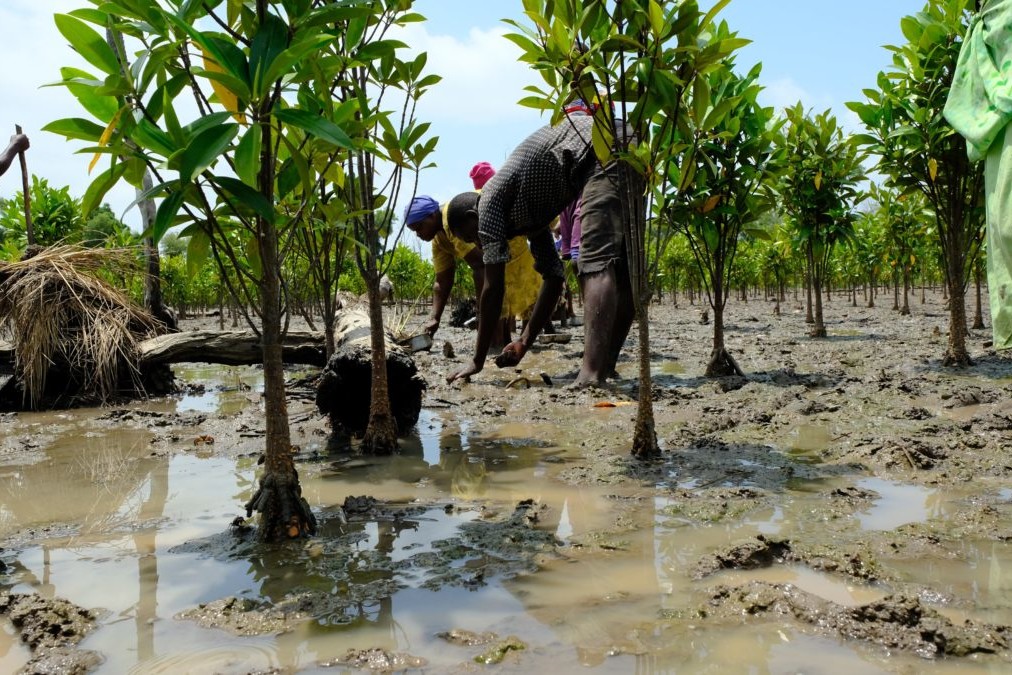|
The MAP News |
|
|
MAP Website en Español haga clic aqui
FEATURED STORY Odisha bid to preserve all mangrove species in a small nursery INDIA - Odisha’s Forest and Environment department officials are elated over rise in mangrove forest in the State, but what excites them more is a small nursery, which may go on to become a field gene-bank for the coastal ecosystem, especially mangroves. Conservation of many important species poses serious challenge as not all of them have seeds or capacity to reproduce vegetatively. Preserving important species in the field is considered as the best mode of conservation, and what can be the best place to preserve mangrove species than the Bhitarkanika National Park. Odisha’s mangrove vegetation constitute only 5.17% of India’s total mangrove cover, but its species diversity is second to none in the country. As far as species distribution in global-level is concerned, only Papua New Guinea has more mangrove species than that of Bhitarkanika in Odisha. “We have tried to showcase Bhitarkanika’s rich species diversity through a nursery being developed at Dangamal. So far we have managed to raise 32 species of mangrove in the nursery. We will double it up by collecting more species from Mahanadi delta areas in next six months,” said J.D. Pati, Divisional Forest Officer of Rajnagar Mangrove (Wildlife) Forest Division. READ MORE GLOBAL The surprising downsides to planting trillions of trees :format(webp):no_upscale()/cdn.vox-cdn.com/uploads/chorus_asset/file/22865251/GettyImages_1191334683.jpg) GLOBAL - Volunteers planted 11 million trees in Turkey as part of a government-backed initiative called Breath for the Future. In one northern city, the tree-planting campaign set the Guinness World Record for the most saplings planted in one hour in a single location: 303,150. “By planting millions of young trees, the nation is working to foster a new, lush green Turkey,” Turkey’s president, Recep Tayyip Erdoğan, said when he kicked off the project in Ankara. Less than three months later, up to 90 percent of the saplings were dead, the Guardian reported. The trees were planted at the wrong time and there wasn’t enough rainfall to support the saplings, the head of the country’s agriculture and forestry trade union told the paper. In the past two decades, mass tree-planting campaigns like this one have gained popularity as a salve for many of our modern woes, from climate change to the extinction crisis. Companies and billionaires love these kinds of initiatives. So do politicians. Really, what’s not to like about trees? They suck up carbon emissions naturally while providing resources for wildlife and humans — and they’re even nice to look at. It sounds like a win-win-win. There’s just one problem: These campaigns often don’t work, and sometimes they can even fuel deforestation. READ MORE 2022 Brings New Conservation Challenges—and Opportunities  GLOBAL – PEW CHARITABLE TRUSTS: As we kick off a new year, it’s a good time to highlight emerging conservation issues that warrant greater research and attention in 2022 and beyond. I recently joined 25 individuals from around the globe to conduct our 13th annual horizon scan—an effort to spot early signs of significant phenomena—to identify issues that are largely unrecognized but likely to have a large-scale impact on conservation within the next five to 10 years. In 2021, we canvassed more than 1,200 experts to identify a list of 80 issues. From there, the panel conducted in-depth research and held virtual discussions to further narrow the field. The resulting study, published in the January issue of Trends in Ecology & Evolution, outlines the top 15 issues for 2022. Several of the issues connect with The Pew Charitable Trusts’ research and advocacy, including commercial seabed mining, the use of environmental DNA (eDNA) to support biological monitoring, and the conservation and restoration of coastal wetlands. Here’s a summary of each of those issues and why they made the final list in our study. READ MORE AFRICA The Women Behind Kenya’s Mangrove Restoration  KENYA - You might have to look closely at the mud to see the thin, green propagules sticking through the ground. Women in multicolored hijabs and kangas are leaning over, tending to these precious seeds and saplings. After a couple of years, they will grow to become full-sized mangrove trees, with root structures visible both above and below the water's surface. This wasn’t always a typical scene in this coastal village on Kenya’s northern coast. In fact, just a few years ago, most community members knew very little about how to protect the mangroves they depended on for a variety of resources like construction material, livestock fodder, medicine, honey, and even mosquito repellent. That all changed in 2018, when The Nature Conservancy and numerous other partners began a project to secure, restore, and improve the management of mangrove ecosystems in Lamu County. The mangroves in Kenya are threatened by overexploitation for wood products, land conversion, and pollution, and more than 40 percent of total mangrove area is now degraded. Lamu County, home to over 60% of Kenya’s mangroves and where TNC has already been engaged in community-based conservation, was the ideal place to focus mangrove conservation efforts. READ MORE Africa faces an uphill battle against western emissions to combat climate change 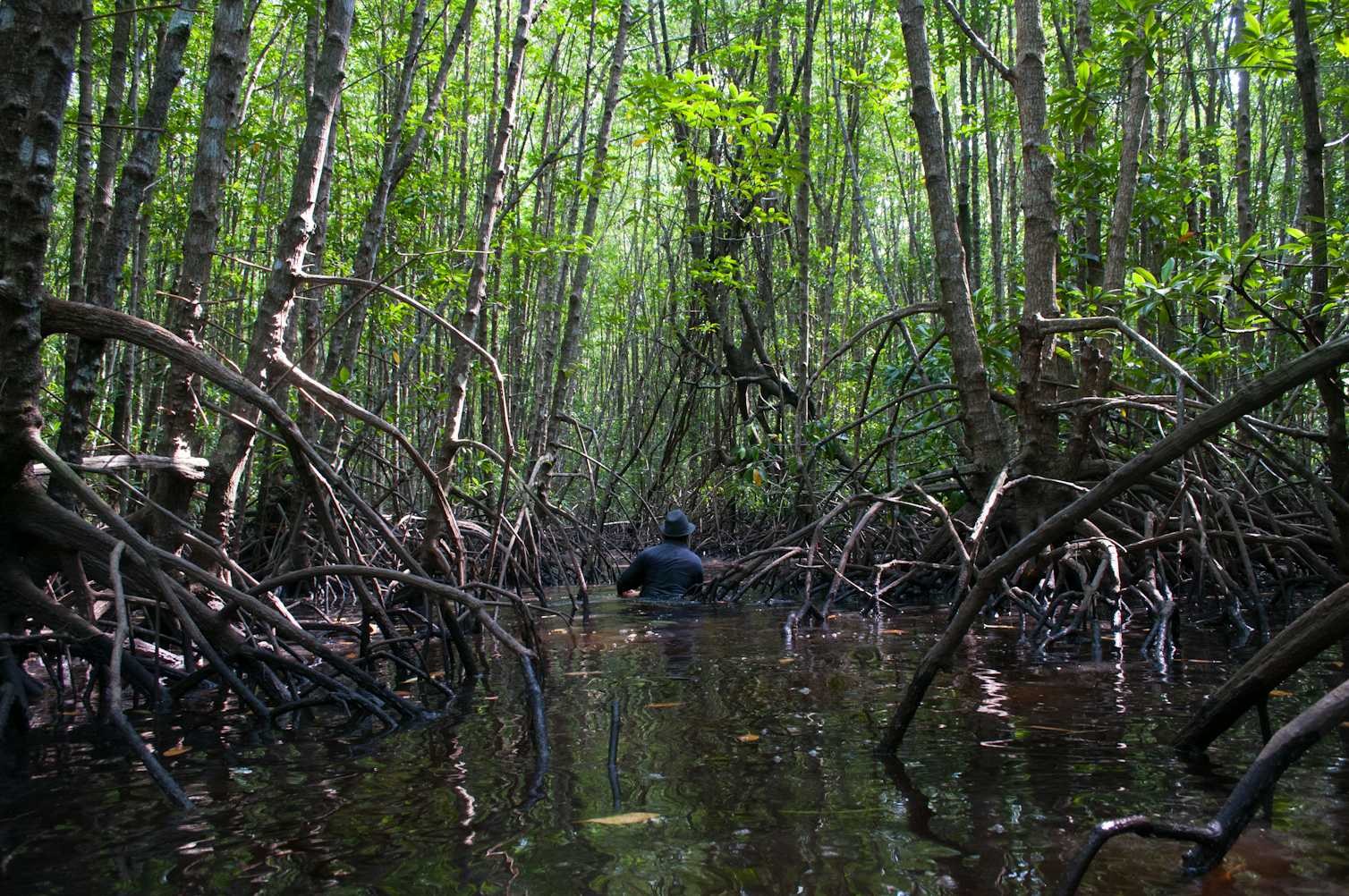 KENYA - The UN climate summit COP26, held in November 2021, focused the world’s attention on the urgent need to tackle climate change and concluded with 197 countries agreeing to the Glasgow climate pact. But opinions on the summit’s success are polarised. We owe a profound gratitude to the developing nations – including those from Africa – who agreed to the pact. In doing so, they chose not to insist that richer developed nations, whose historical and ongoing greenhouse gas emissions have largely caused the climate crisis, pay reparations to them for the damage they’ve inflicted. At the same time, the threat to GDP of African nations that are most vulnerable to these changes – meaning the amount of economic activity that stands to be lost if these changes are severe enough – is projected to increase from £660 billion in 2018 to over £1 trillion in 2023. That’s almost half of the continent’s projected GDP. Given these estimates, Africa’s climate resilience must exceed the global norm. And some steps are being taken to protect the continent against the worst climate consequences through investments from national governments and the private sector. Organisations such as the African Development Bank and the UN Environment Programme are also leading climate change adaptation measures, like working to protect mangroves on over 200 million hectares of land. READ MORE AMERICAS What’s In the Water?  USA - The tendency for most of us when it comes to human wastewater is out of sight, out of mind. Rarely do we consider what happens after we flush that toilet or turn off that tap. However, researchers at UC Santa Barbara have turned their attention and considerable computational power to the subject and its impacts on global coastal ecosystems. The results aren’t pretty, but they are enlightening. “The motivation behind this research was a desire to have a fine-grain understanding of how wastewater is impacting coastal waters worldwide,” said Cascade Tuholske, the lead author of a paper(link is external) that appears in the journal PLOS One. While research on terrestrial threats to coastal marine ecosystems often focuses on agricultural runoff and what happens when fertilizer and livestock waste winds up in the ocean, he said, few studies investigate what happens when human sewage does the same. READ MORE ASIA Womangrove collective reclaims the coast from shrimp farms 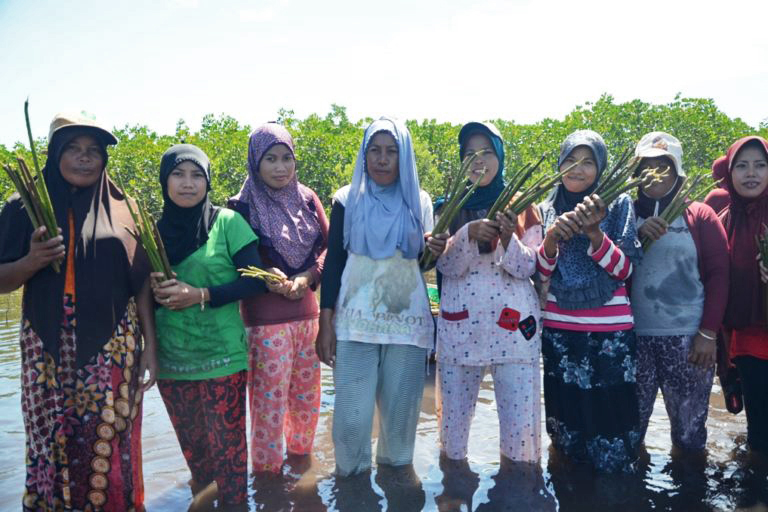 INDONESIA - In the years since it was formed, the business aspect of the collective has proved hard to sustain, with members citing the difficulty of getting goods from their remote islands to the right markets. But the women of Womangrove say they have benefited in other significant ways. “In the long term, these women are developing critical skills,” Hayati said. “We are heavily involved in various village programs but now we’re working to improve them too, something that didn’t happen before.” Some of the women who have been involved in the program have even become village officials thanks to the administrative and speaking skills they learned through their involvement in the various workshops conducted by Oxfam’s Restoring Coastal Livelihoods (RCL) program. Hayati said people in Tanakeke often see mangroves as just a source of firewood or building materials. She said one of Womangrove’s biggest achievements has been changing this mindset. “There is an emerging awareness of how important it is to protect mangroves because they protect the islands from erosion and the brunt of big tidal waves,” she said. “Women play a very important role in this because it is closely related to everyday life. It’s also about equality.” READ MORE Fishermen given compensation for releasing protected marine species 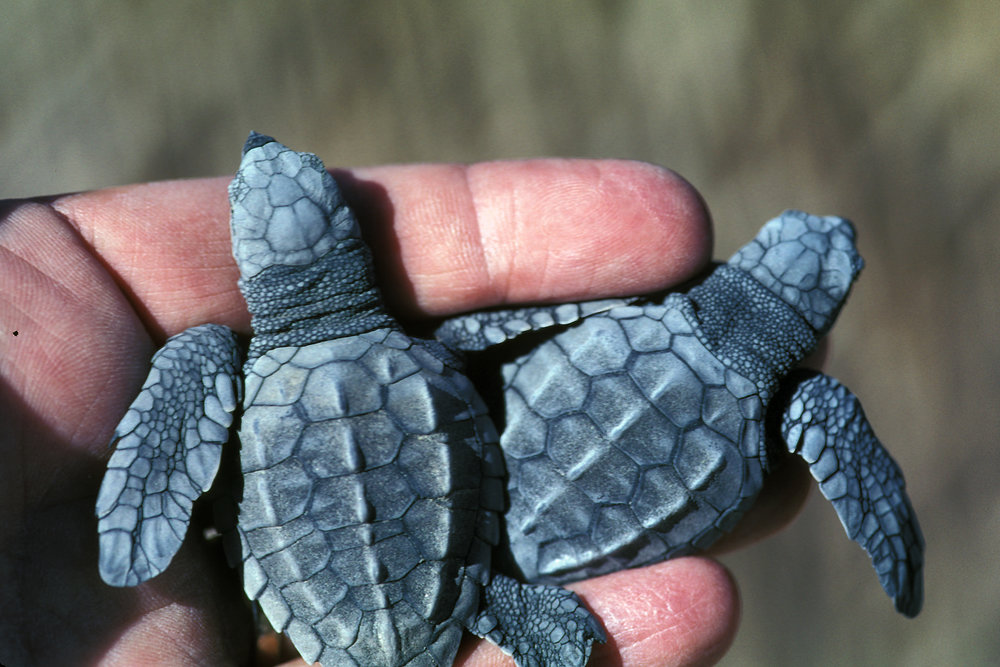 INDIA - Fishermen in the coastal districts of Maharashtra have received Rs 40.78 lakh as compensation in the last three years for safely releasing 260 protected marine species, including Olive Ridley and green sea turtles, that were accidentally caught in their fishing nets, an official release has said. This compensation is being paid as part of the scheme jointly launched by the state forest and fisheries departments in December 2018, which is aimed at conserving the rare and protected marine creatures, it said. So far, 138 Olive Ridley turtles, 67 green sea turtles, 5 hawksbill turtles, two leatherback sea turtles, 37 deer sharks, six giant guitar fish, humpback dolphin), four finless porpoises have been released into the sea, it said. It includes mangrove subsistence creation, mangrove afforestation, mangrove nature tourism, and removal of encroachments on mangroves, among others.Maharashtras mangrove cover is 32,000 hectares, it said, adding that while protecting mangroves, they are being given the status of reserved forests. READ MORE Indonesia aims for sustainable fish farming with ‘aquaculture villages’ 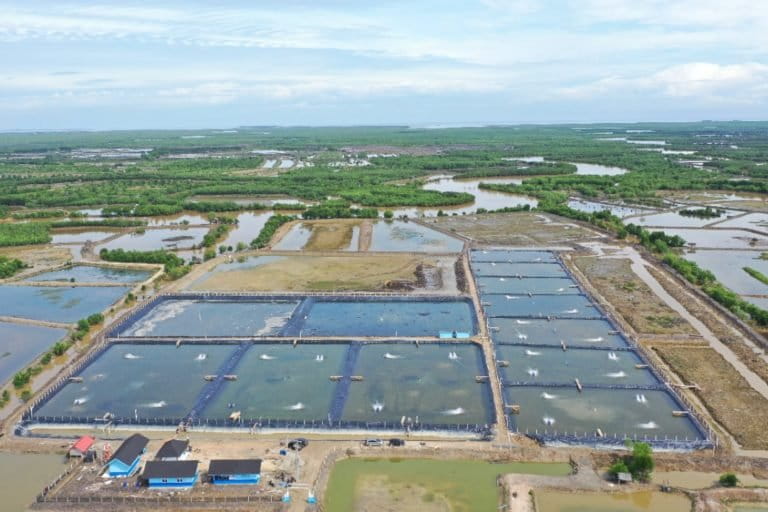 Editor's note: We at MAP remain vigilant concerning this plan by the government to revitalize its shrimp aquaculture programs while also stating its commitment to mangrove conservation and restoration. In the past, these two initiatives have not been compatible, and inevitably the quick profit motives of the shrimp farm industry have outstripped the conservation resolve of the government.- AQ INDONESIA - The Indonesian government plans to have a network of dozens of villages with aquaculture farms by the end of the year, in a bid to spur the post-pandemic economic recovery by catering to global demand for farmed seafood. Indonesia’s fisheries ministry said in December that it has established six of these so-called aquaculture villages and would add 130 more by the end of 2022. The villages will cultivate high-value aquaculture commodities, including shrimp, lobster, crab and seaweed. “Boosting production of commodities for exports comes first,” TB Haeru Rahayu, the ministry’s director-general of aquaculture fisheries, said at an online event. He added the program would strengthen the country’s food security and create new jobs. Developing aquaculture farms in Indonesia has typically entailed clearing carbon-rich mangrove forests to build the shrimp and fish ponds, said Abdul Halim, executive director of the Center for Maritime Studies for Humanity. Over the past three decades, Indonesia has lost nearly half of its mangrove area, according to the Center for International Forestry Research (CIFOR). In 2021, President Widodo set an ambitious goal of replanting mangroves on 600,000 hectares (1.5 million acres) of degraded coastline by 2024. READ MORE OCEANA St Kilda mangrove remediation could cost 'tens of millions' unless action is taken AUSTRALIA - A South Australian senator has warned that taxpayers could end up footing the bill to fix an environmental disaster in the St Kilda mangroves, north of Adelaide. The Environment Protection Authority (EPA) is still investigating the events of 2020, when water seeping from neighbouring salt ponds is believed to have caused a large section of mangroves to die. Freedom of Information documents obtained by independent senator Rex Patrick show that salt ponds operator, Buckland Dry Creek, did not have a bond in place as part of its environmental agreement with the South Australian government. "The government has spent $2.7 million just looking at how the site would be remediated," Senator Patrick said. "I suspect remediating 28 kilometres of salt ponds is going to run into the tens of millions of dollars. Right now, the responsibility for that does rest with the miner but we don't know what could happen in the future. READ MORE FEATURED VIDEO CAYMAN ISLAND CENTRAL MAGROVES An aerial view of Grand Cayman's Central Mangrove Wetland - the largest contiguous mangrove wetland in the Caribbean. Under threat from uncontrolled development. 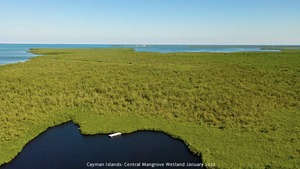
|
ACTION ALERTS Stop construction work on a private port In Defense of the Quilombo Boca Do Rio TAKE ACTION! Tell Sumitomo to stop building polluting coal power in Bangladesh! TAKE ACTION!
MAP Website en Español
13 Year old Linda Li "Mangrove Adventure" from Kid Dream Art School
Video: Mangroves for the Future WANT TO GET INVOLVED?
Like this newsletter? Pease consider donating to MAP to keep it going. Giving could never be easier
Interested in connecting or working with MAP? Check out our opportunities here MANGROVE ISSUES Want to learn more about mangroves? What is CBEMR? Download MAP's 2 page CBEMR Information Sheet containing links to all MAP's CBEMR resources – CLICK HERE View MAP’s uploaded Videos at Question Your Shrimp Consumer/Markets Campaign! Mangroves: Guidebook to Malaysia – Click Here SHARE MAP'S VISION Our short documentary, Reducing the Risk of Disaster through Nature-Based Solutions : Mangroves Marvellous Mangroves Curriculum The Marvellous Mangroves Curriculum begins with a simple philosophy – getting future generations to not only learn about, but understand the importance of mangrove forests. VISIT
Marvellous Mangroves Curriculum in Bangladesh - WATCH VIDEO
Like this newsletter? Pease consider donating to MAP to keep it going. Giving could never be easier
"Question Your Shrimp" Campaign Question Your Shrimp - is it really sustainable? Sign the Petition
We strive to keep active links in our newsletter. However, due to circumstances beyond our control, occasionally links to stories may become broken. If you find a link to a story is not functioning, please cut and paste the headline into your browser search bar. In most cases you should be able to locate the original story. Not yet a MAP News subscriber? |
|
Mangrove Action Project Click here to view past newsletters
|
|
Search News Archive
Saturday, January 22, 2022
MAP News Issue #538 - Jan 22, 2022
Saturday, January 8, 2022
MAP News Issue #537 - Jan 08, 2022
|
The MAP News |
|
|
MAP Website en Español haga clic aqui
FEATURED STORY An Appeal from our Executive Director for the Mangroves 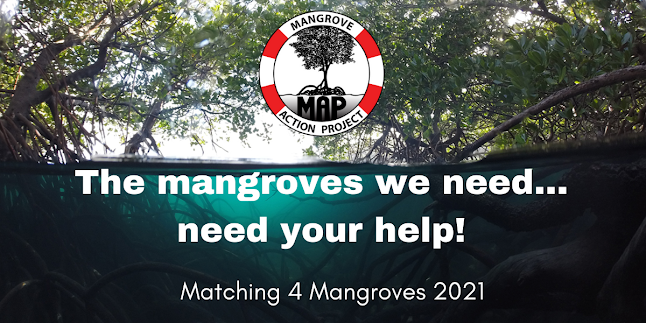 Maybe world leaders are finally reading the writing on the wall? Maybe they finally understand that the recent frightening weather, massive forest fires, droughts and floods are not just chance occurrences but due to our planet-level experiment of increasing CO2 levels from the pre-industrial 280ppm to 415ppm today. There’s no argument about these numbers or the greenhouse gas effect – it’s just straight physics. We can debate the link between CO2 levels and climate change. Or we can take practical action now. Please support MAP to do what the world should be doing, climate change or not – conserving existing mangroves and restoring degraded forests, as fast as possible. Why mangroves in particular? Because they form an amazing intertidal ecosystem that provides all sorts of benefits, local and global, but are under threat from shrimp farming, urban development, road building, sea walls, oil palm expansion, sea level rise and other challenges. MAP is blessed by having a passionate, experienced, highly qualified and loyal team. We need funding to run more capacity-building and outreach programs, and advocate for mangroves at conferences and meetings such as COP26. You can help us to increase MAP’s impact by donating to MAP now. READ MORE GLOBAL Many Overheated Forests May Soon Release More Carbon Than They Absorb  GLOBAL - The last decades have been filled with dire warning signs from forests. Global warming has contributed to thinning canopies in European forests and to sudden die-offs of aspen trees in Colorado, as well as insect outbreaks that are killing trees around the world. In many places, forests are not growing back. New research shows that Earth’s overheated climate will alter forests at a global scale even more fundamentally, by flipping a critical greenhouse gas switch in the next few decades. The study suggests that, by 2040, forests will take up only half as much carbon dioxide from the atmosphere as they do now, if global temperatures keep rising at the present pace. The study, published Wednesday in Science Advances, analyzed more than 20 years of data from about 250 sites that measure the transfer of carbon dioxide between land and plants and the atmosphere—the way the planet breathes. READ MORE AFRICA Mangrove Biodiversity Management Project Officially Lanched in Lake Piso 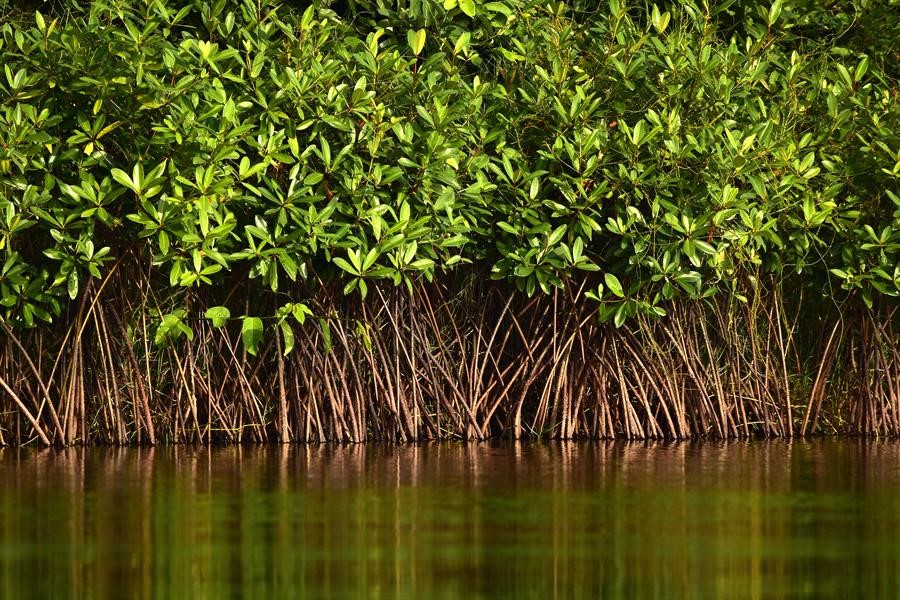 LIBERIA - A grand launch marking the Lake Piso Multiple Use Reserve sustainable Mangrove Biodiversity mangemnt project has taken place in Robertsport City, Grand Cape Mount County with stakeholders unanimously promising to ensure the successful implementation of the project. The project titled: “Managing Mangrove Forests from Senegal to Benin is being implemented by the Forestry Development Authority (FDA) with funding support from the International Union for the Conservation of Nature (ICUN). On December 5, 2020, the FDA and the Wetlands International Africa (WIA) jointly conducted an awareness workshop held at Lake Piso where the Liberian stakeholders were urged to submit proposals in the wake of the euros 9,900,000 grant provided by the European Union to promote, protect and conserve wetlands in 9 West African countries including Liberia. The application for the grant began December 20, 2020-January 20, 2021, and Liberia was one of the successful applicants. READ MORE AMERICAS Saving Grand Bahama’s Mangrove Forest 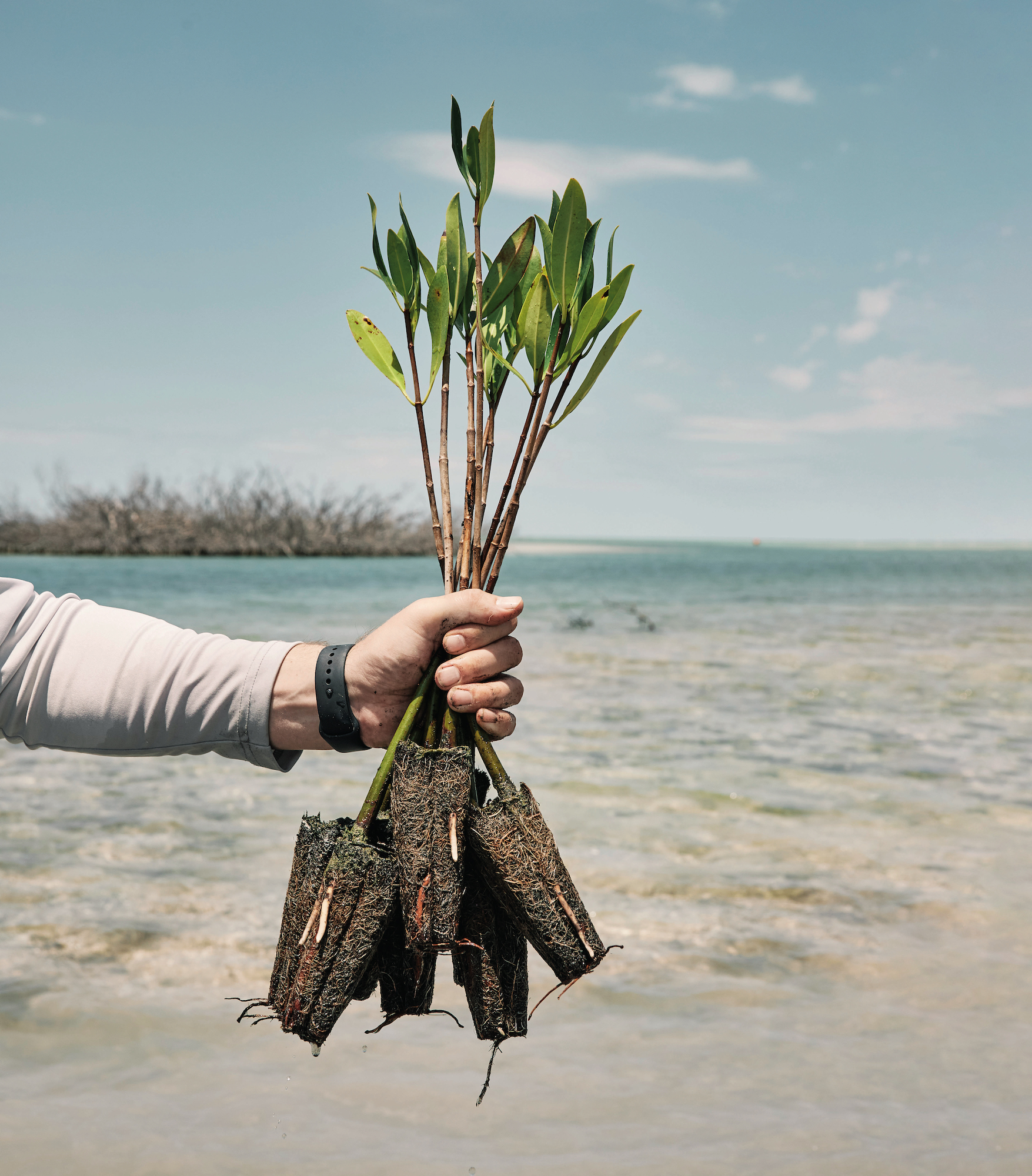 BAHAMAS - When Hurricane Dorian made landfall in the Bahamas on September 1, 2019, its 185-mile-per-hour winds made it the strongest storm ever to hit the archipelago. Dorian ravaged Marsh Harbour on Great Abaco Island, then crossed open water and stalled over the East End of Grand Bahama for more than twenty-four hours. There, the hurricane pushed an unprecedented twenty-foot storm surge over the small fishing settlements of McLean’s Town, High Rock, and Sweeting’s Cay. Some 60 percent of all of Grand Bahama Island, including Freeport, was under water. When the waters receded, the toll on human life, homes, and commercial buildings was staggering: The official estimate of lives lost stands at seventy-four, but scores more are still missing. Damage estimates soared to $3.4 billion. READ MORE ASIA To dye for: Indonesia's carbon-rich mangroves in fashion with women weavers  INDONESIA - In a rural office on Bengkalis island, off the northeast coast of Sumatra, 30-year-old Mayasari runs a face mask dyed with tree sap through an antique sewing machine. The day before, Mayasari, who goes by one name, and a dozen other women in Pedekik village learned to make hand sanitisers with an extract from the mangrove trees that fringe the coast. “Alhamdulillah (praise be to god) — if this comes from nature in Bengkalis, then it is great,” Mayasari told the Thomson Reuters Foundation. The Bengkalis training is the first government programme aimed at addressing the double hit from coronavirus and climate change among mangrove-dwelling communities in Indonesia. The face masks made by the Pedekik women’s group are sold for 2,000 rupiah (US$0.14) each, offering a new source of income for members. READ MORE Plantation of ten billion trees holds immense significance for Pakistan  PAKISTAN - Prime Minster of Pakistan (PM) Imran Khan on Tuesday said that the plan of planting 10 billion trees holds immense significance for Pakistan. While addressing the ceremony after signing the agreement between World Banks and Ministry of Climate Change, PM Imran said that the mutual pact is vital for the prosperity of Pakistan. He added that we are thankful to the World Bank and the country is influenced by the climate change. In order to stop the global warming, country must take important measures. The rain is reduced across the country. Rainfalls have reduced in Dera Ismail Khan (DIK) as well. Various countries are tensed over the matter of culminating environmental pollution in the globe. Due to the increased number of fire, flood and other incidents of catastrophes destroying the forest, the frequency of the rainfall has decreased. The glaciers are melting down due to the increased temperature. READ MORE In Indonesia’s Sulawesi, a community works to defuse blast-fishing crisis  INDONESIA - Decades of blast fishing have destroyed much of the coral reefs off Indonesia’s Lora village, reducing fish catches. Lora also used to retain a buffer of mangrove trees, which helped provide food security for the 412 families who live along the village’s 7-kilometer (4-mile) coastline. Increased law enforcement and advocacy by NGOs has helped roll back these destructive practices, but other threats loom, including increasingly unpredictable weather and competition from large trawlers. A community organization is seeking to have the region zoned as a conservation area. Blast fishing has long been illegal in Indonesia, and other coastal and island nations, where millions rely on nearshore fishing grounds for income and food security. Around 80% of Indonesia’s 2.4 million fishers operate small boats and fish only near shore, according to Rare, a U.S.-based conservation organization that partners with fishers in Lora. Use of homemade bombs, often fashioned from fertilizer and kerosene, is one of the world’s most destructive forms of fishing, according to the United Nations Environment Programme. The explosives kill indiscriminately, blowing up everything from fish eggs to dolphins, while rupturing vast stretches of coral reefs already endangered by climate change. READ MORE Build ‘coastal greenbelts’  PHILIPPINES - Siargao became known to the world for its surfing sites but, in the aftermath of Supertyphoon Odette, another feature of the island is getting the spotlight: its mangroves, which have been credited with helping protect adjacent communities from the severest impact of the storm. According to reports from those who survived the destruction that Odette brought to the Visayas and Mindanao regions several days before Christmas, Siargao’s mangrove forests protected residents from a storm surge headed toward Del Carmen, one of the nine municipalities in the island. The municipality boasts of the largest mangrove forest in the Philippines, covering 4,871 hectares. Extreme storms like Odette and Yolanda highlight the need for building what Mindanao marine scientist Jurgenne Primavera calls “coastal greenbelts.” Primavera, recognized by Time magazine as a “Hero of the Environment” in 2008 for her work on mangrove ecosystem conservation, has called for legislation that would create a belt of mangrove forests across the Philippines to protect coastal communities from severe disasters. READ MORE SMC, govt join to protect NCR's last old mangrove forest 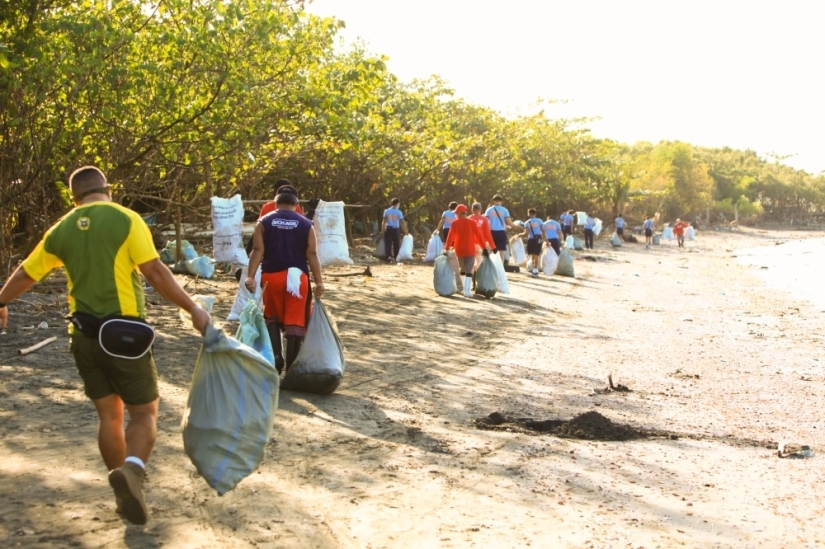 PHILIPPINES - TOGETHER with the Department of Environment and Natural Resources (DENR) and the local government of Navotas, SMC continued to tap more volunteers from its own workforce to scale up efforts to clean and protect Isla Pulo, home to the remaining old-growth mangrove forest in the National Capital Region (NCR). Holding weekly cleanup activities since October, SMC has, so far, mobilized some 80 volunteers, consisting of employees; residents from Barangay Tanza 1; and personnel from the local government of Navotas, the Philippine National Police in Navotas, the 51st Engineers Brigade of the Philippine Army, and the DENR. Volunteers have, so far, collected 3,803 sacks of garbage from the mangrove area, which also serves as a natural barrier that protects nearby cities from storm surges and coastline erosion. The primary goal was to remove the trash that littered the 3.5-kilometer shoreline and mangrove strip of the 26-hectare island. The initiative complemented the company's cleanup of the Tullahan-Tinajeros river system and helped in flood mitigation efforts. READ MORE Deepen understanding of Indian mangrove ecosystems, says mangrove scientist  INDIA - Getting things right with mangroves, ecosystems that feature on the global climate agenda for their carbon storage capacity, could set the stage for effective climate action and biodiversity protection in coastal areas, says noted mangrove scientist K. Kathiresan. Kathiresan, who has worked extensively in Tamil Nadu’s Pichavaram mangroves, said restoring mangroves with a focus on biodiversity (diverse mangrove plant species and fauna) and in the right place, instead of growing mangrove monocultures, are crucial to mangrove health. He said that the involvement of local communities in the planning, execution and monitoring of plantation projects and a deeper understanding of fauna and micro-organisms associated with these amphibious defenders is key to climate action centred on mangrove ecosystems. READ MORE Mangrove Foundation deploys app to streamline data collection on Olive Ridley turtles 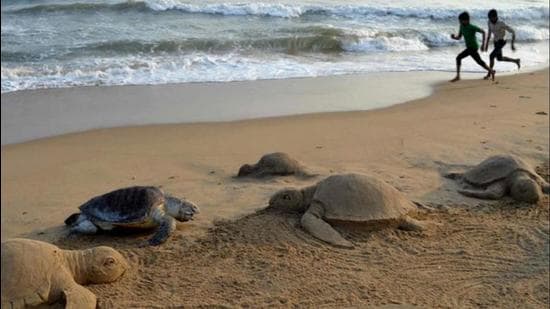 INDIA - Application named M-Turtle to help streamline collection of data on the nesting patterns of Olive Ridley turtles in Ratnagiri, Sindhudurg and Raigad districts where they are known to lay eggs between December and March.The Mangrove Foundation - an autonomous society under the Maharashtra forest department’s mangrove cell - on Tuesday launched a mobile application named M-Turtle to help streamline collection of data on the nesting patterns of Olive Ridley turtles in Ratnagiri, Sindhudurg and Raigad districts where they are known to lay eggs between December and March. The app was created in collaboration with Chiplun-based NGO, Sahyadri Nisarga Mitra, which has been working with the Mangrove Foundation on sea turtle conservation in Maharashtra, and which is the first organisation in the state to start a sea turtle conservancy programme in Ratnagiri’s Velas village. READ MORE It's 'now or never' to save existing wetlands or flamingos won't come back 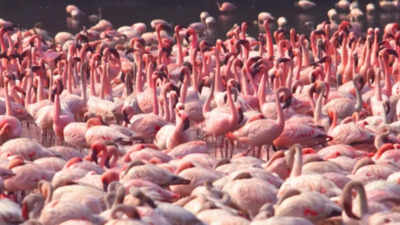 INDIA – Even as the Navi Mumbai Municipal Corporation (NMMC) has started displaying creative, colourful paintings and sculptures of flamingos on the city walls and places for the next Swachhata contest, the local environmentalists have urged the authorities that the very fact that wetland birds like flamingos and ducks are being painted for beautification, it is high time that the civic body and others also protect the existing wetlands at Seawoods, Kharghar and Uran. The activists said that they are also writing to the Raigad and Thane collectors to include these wetlands in the updated list that will be sent to the state environment department by January 15 this year. Adding that it is "Now or Never", the greens said that this is their final push to protect the surviving wetlands, otherwise, the birds like flamingos will cease to be seen there, and instead " will only be viewed as pictures on walls and books". READ MORE |
ACTION ALERTS Stop construction work on a private port In Defense of the Quilombo Boca Do Rio TAKE ACTION! Tell Sumitomo to stop building polluting coal power in Bangladesh! TAKE ACTION!
MAP Website en Español
ORDER YOUR 2022 MAP CHILDREN'S ART CALENDER HERE 13 Year old Linda Li "Mangrove Adventure" from Kid Dream Art School
Video: Mangroves for the Future WANT TO GET INVOLVED?
Like this newsletter? Pease consider donating to MAP to keep it going. Giving could never be easier
Interested in connecting or working with MAP? Check out our opportunities here MANGROVE ISSUES Want to learn more about mangroves? What is CBEMR? Download MAP's 2 page CBEMR Information Sheet containing links to all MAP's CBEMR resources – CLICK HERE View MAP’s uploaded Videos at Question Your Shrimp Consumer/Markets Campaign! Mangroves: Guidebook to Malaysia – Click Here SHARE MAP'S VISION Our short documentary, Reducing the Risk of Disaster through Nature-Based Solutions : Mangroves Marvellous Mangroves Curriculum The Marvellous Mangroves Curriculum begins with a simple philosophy – getting future generations to not only learn about, but understand the importance of mangrove forests. VISIT
Marvellous Mangroves Curriculum in Bangladesh - WATCH VIDEO
Like this newsletter? Pease consider donating to MAP to keep it going. Giving could never be easier
"Question Your Shrimp" Campaign Question Your Shrimp - is it really sustainable? Sign the Petition
We strive to keep active links in our newsletter. However, due to circumstances beyond our control, occasionally links to stories may become broken. If you find a link to a story is not functioning, please cut and paste the headline into your browser search bar. In most cases you should be able to locate the original story. Not yet a MAP News subscriber? |
|
Mangrove Action Project Click here to view past newsletters
|
|
-
The community of adults and youth in Cayman Islands has come together recently to release a series of educational videos. Each is geared to...
-
By Alfredo Quarto, Program & Policy Director Co-founder, MAP There is a rather urgent situation concerning the bio-invasion of the Son...
-
By: Isabel Robinson, MAP Volunteer Intern Some months ago I decided to come to Thailand and do an internship in mangrove conservation, ...
MAP News Issue #596 = April 20, 2024
ENTRIES NOW OPEN! Mangrove Photography Awards 2024 10 Years Celebrating Mangroves GLOBAL - MAP has launched our 10th Mangrove Photograp...



